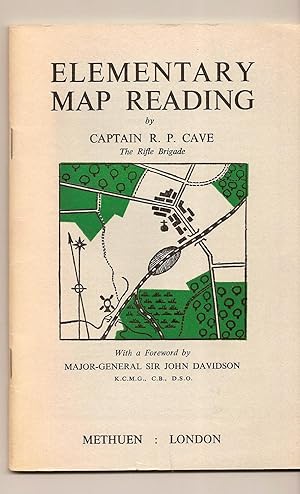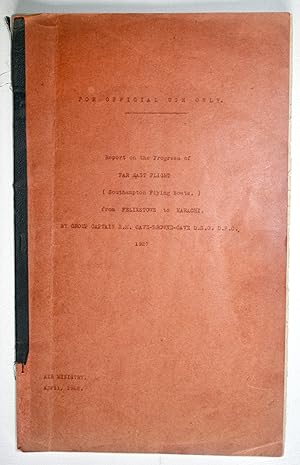Cave Captain (3 results)
Product Type
- All Product Types
- Books (3)
- Magazines & Periodicals
- Comics
- Sheet Music
- Art, Prints & Posters
- Photographs
- Maps
-
Manuscripts &
Paper Collectibles
Condition
- All Conditions
- New
- Used
Binding
- All Bindings
- Hardcover
- Softcover (2)
Collectible Attributes
- First Edition
- Signed
- Dust Jacket
- Seller-Supplied Images (2)
- Not Printed On Demand
Seller Location
Seller Rating
-
Elementary Map Reading
Published by Metheun & Co. Ltd, London, England, 1964
Seller: BYTOWN BOOKERY, Vars, ON, Canada
Stapled wraps. Condition: Very Good. Dust Jacket Condition: No Dust Jacket. A smaller booklet with stapled wraps, a bit of discoloration to the spine hinge area. Well bound with an unmarked interior. On the title page is a 'Complimentary Copy' sticker to the previous owner. A forward by: Major-General Sir John Davidson. ; Maps; 12mo 7" - 7½" tall; 48 pages.
-
ASTOUNDING 1930 SEPTEMBER
Published by publishers fiscal
Seller: GRAHAM HOLROYD, BOOKS, Webster, NY, U.S.A.
near fine unread, but the title page is glued to the back of the front cover.
-
Report on the Progress of Far East Flight (Southampton Flying Boats) from Felixstowe to Karachi 1927 (For Official Use Only)
Published by Air Ministry, London, 1928
Seller: Dendera, London, United Kingdom
Book
Soft cover. Condition: Good. Foolscap mimeograph in printed russet wraps with black cloth spine,(1), 51pp printed on semi-absorbent mimeo paper with George V S.O. (Stationery Office) watermark + 12 full-page diagrams (maps). Covers good with loss to spine cloth, interiors good, lightly tanned, spotted with wear at some edges. Extremely rare. The RAF Far East Flight explored routes, facilities, and the practicalities of flying to the farthest reaches of Empire, independent of surface vessels and shore bases, and it sought to promote cooperation within the Empire. It used four new Supermarine Southampton II flying boats, which among other modifications were fitted out for living aboard. The Flight was done in 4 Sections: 1. Felixstowe-Karachi (14 Oct - 18 Nov 1927); 2. Karachi - Singapore (18 Dec - 28 Feb 1928); 3. Singapore-Australia-Singapore (21 May - 15 Sep 1928); and 4. Singapore-Hong Kong-Singapore (1 Nov - 11 Dec 1928). Group Captain Henry Cave-Browne-Cave led (in S-1149), with Squadron Leader GE Livock 2nd-in-command (S-1150), and Flight Lieutenants DV Carnegie (S-1151) and CG Wigglesworth (S-1152). At the end, the unit remained at Seletar in Singapore, becoming the RAF's 205 Squadron headed by CBC. His self-contained report describes the first Section. Dated April 1928, it was issued between the second and third Sections. It includes a summary with appendices containing daily diary (progress, people met, times, speeds, sleeping arrangements etc), statistics, notes on harbour facilities, meteorology, equipment, navigation, finance, stores, living conditions in flying boats, and their modifications. Leaving Felixstowe in unpleasant rain and thick mist, the Section was mostly "very smooth". The Flight received "greatest assistance and hospitality" from British, French and Italian air forces and air attaches, local authorities, British Consuls and other reps, with much interest shown along the way. Among some of the problems and incidents, failure to get fuel to Brindisi led to delay and detour. Stronger than forecast headwinds from Alexandretta to Baghdad forced a refuelling and overnight stop at Ramadi. An appreciative King Faisal (here named "Ali") was taken for a flight over Baghdad, and CBC called on the Palace and Prime Minister the following day. Meanwhile all personnel were inoculated for cholera at Hinaidi Hospital owing to an outbreak. The mooring site at Basra provoked "great objection" due to "native boat traffic which passes constantly day and night and if there is no wind completely out of control". This prompted a nighttime guard, and "many native craft had to be towed clear". The Flight identified Gurmat Ali as a suitable base. They were advised not to land in Persia as they would be quarantined for cholera. Thus refuelling, medical and other assistance coordinated by Acting Consul and Squadron Leader Keith aboard his Presidency Launch "Percy Cox", was made available from the HMS Enterprise and Triad off Bushire and Henjam Island (the latter with RN golf course, cricket ground, tennis court, officers' club and canteen). Over Oman the Flight went slightly off course to survey Khasab and other bays as potential seaplane bases, finding the area too open, mountainous and desolate even in an emergency. At Gwadar they were assisted by Flying Officer Simpson from Karachi. The representative of the Sultan of Muscat and other notables visited. The Political Officer for Makran had travelled down to greet them: "In order to relieve him from another long journey by camel and car back to his district, he was offered and accepted a passage to Karachi" with Political Officer Captain Smith. The moorings at Karachi while satisfactory were also subject to collision with local traffic. The Statistics link to the 12 maps (Hourtin, Berre, Nisida, Brindisi, Phaleron, Abukir, Alexandretta, Hinaidi, Magil (Basra), Bushire, Henjam Sound, Gwadar Bay), with cautions and other supporting information.




